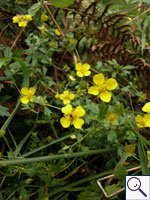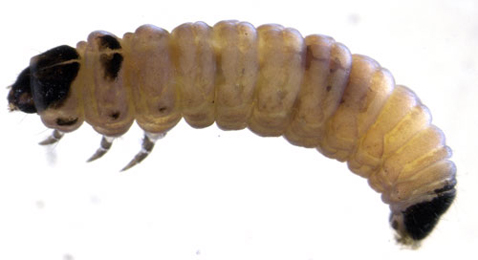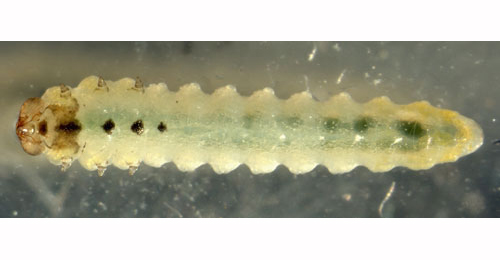|
||||||
|
POTENTILLA. Cinquefoils, Barren Strawberry, Silverweed and Tormentil. [Rosaceae] |
|
|
Thirty-three species of Potentilla are recorded in Britain. These include the native Trailing Tormentil (P. anglica), Silverweed (P. anserina), Barren Strawberry (P. sterilis), Marsh Cinquefoil (P. palustris), Tormentil (P. erecta) and Creeping Cinquefoil (P. reptans). The BSBI provide a downloadable plant crib for Potentilla and vegetative Potentilla vesca and sterilis. Potentilla palustris is treated as Comarum palustre by Stace (2010). Rock Cinquefoil (P. rupestris) is protected under Schedule 8 of the Wildlife and Countryside Act, 1981. Thirteen British miners are recorded on Potentilla. A key to the European miners recorded on Potentilla is provided in Bladmineerders van Europa. |
 Tormentil Potentilla erecta |
Key for the identification of the known mines of British |
Note: Diptera larvae may live in a corridor mine, a corridor-blotch mine, or a blotch mine, but never in a case, a rolled or folded leaf, a tentiform mine or sandwiched between two more or less circular leaf sections in later instars. Pupation never in a cocoon. All mining Diptera larvae are leg-less maggots without a head capsule (see examples). They never have thoracic or abdominal legs. They do not have chewing mouthparts, although they do have a characteristic cephalo-pharyngeal skeleton (see examples), usually visible internally through the body wall. The larvae lie on their sides within the mine and use their pick-like mouthparts to feed on plant tissue. In some corridor miners frass may lie in two rows on alternate sides of the mine. In order to vacate the mine the fully grown larva cuts an exit slit, which is usually semi-circular (see Liriomyza huidobrensis video). The pupa is formed within the hardened last larval skin or puparium and as a result sheaths enclosing head appendages, wings and legs are not visible externally (see examples). See Key to non-Diptera. |
1a > Leaf-miner: Initially a linear mine which later develops into a conspicuous blotch; frass in two rows in linear section, scattered irregularly in the blotch (Spencer, 1976: 134-5, fig. 237, as potentillae). Corridor, gradually and considerably widening towards the end. Frass in two rows in the corridor part, further up dispersed irregularly. Pupation outside the mine. A short broad upper surface corridor leading to a long blotch between veins. |
|
Agromyza idaeiana (Hardy, 1853) [Diptera: Agromyzidae]. |
| 1b > Leaf-miner: Mine
frequently starting along leaf margin, initially linear, later developing
into an elongate blotch, frass in two distinct rows, even at end
(Spencer, 1972b: 30, fig.
74; Spencer, 1976: 144, fig.
263A).
First a long corridor, its initial part often along the leaf margin or a thick vein. Rather suddenly the corridor widens into a broad blotch. The corridor contains much, amorphous frass that sometimes seems to fill the entire corridor (lower picture). In the blotch the frass is in black strings and coarse lumps. (In rainy weather they liquify and loose their shape). Pupation outside the mine. A narrow upper surface gallery to start, then broadening and zigzagging to create a false blotch. |
|
Agromyza sulfuriceps Strobl, 1898 [Diptera: Agromyzidae]. |
1c > Leaf-miner: A long linear mine, never widening into a blotch at end (Spencer, 1976: 107-8, fig. 167). Long upper-surface corridor. Many straight stretches, often along the midrib. Frass in discrete grains, here and there in thread fragments, but never in pearl strings. Pupation outside the mine. A long straight mine, which is sometimes branched. Found in the upper leaf surface. |
|
Agromyza filipendulae Spencer, 1976 [Diptera: Agromyzidae]. |
|
Key for the identification of the known mines of British |
Note: The larvae of mining Coleoptera, Hymenoptera and Lepidoptera may live in a corridor mine, a corridor-blotch mine, a blotch mine, a case, a rolled or folded leaf, a tentiform mine or sandwiched between two more or less circular leaf sections in later instars. Larva may pupate in a silk cocoon. The larva may have six legs (although they may be reduced or absent), a head capsule and chewing mouthparts with opposable mandibles (see video of a gracillarid larva feeding). Larvae of Hymenoptera and Lepidoptera usually also have abdominal legs (see examples). Frass, if present, never in two rows. Unless feeding externally from within a case the larva usually vacates the mine by chewing an exit hole. Pupa with visible head appendages, wings and legs which lie in sheaths (see examples). |
1a > Leaf-miner and case-bearer: The larva lives outside the mine, protected by a case, and feeds on the underlying plant tissues via a hole cut in the epidermis. From that point it eats away as much leaf tissue as it can reach without fully entering the mine. Mine does not contain frass (Coleophora species) |
1b > Leaf-miner, but not a case-bearer: The larva lives mainly inside the mine. Mine usually contains frass. In later instars the larva may live sandwiched between two more or less circular sections cut from the leaf. |
2a > Leaf-miner and case-bearer: The case resembles that of C. violacea, but does not lie so flat again the leaf as this species (having a mouth angle of 30 to 50°). C. violacea also has a case which bulges in the middle, whereas in C. potentillae the case tapers towards the posterior. Immediately after emergence the larva makes a full depth, quickly widening, corridor, with frass as small grains in a broad central band. Finally results a blotch of 2 x 5 mm, from which the youth case is cut. The fully developed case is a hairy, greyish brown to silver grey lobe case of about 1 cm long, with a clearly laterally compressed end; the mouth angle is about 90°. The case is difficult to separate from that of C. ochripennella. |
|
Coleophora potentillae (Elisha, 1885) [Lepidoptera: Coleophoridae]. |
2b > Leaf-miner and case-bearer: The larva feeds on a wide range of trees, shrubs and herbs, favouring Rosaceae, but not exclusively. The fully developed cased larva may be found active in October and again, after winter diapause, in April. Cases, about 6 mm, of diapausing larvae may be found through winter, fixed to a tree or fence post. The dorsal surface of the case is usually covered in leaf fragments, but they can sometimes be worn off almost smooth. The ventral surface is swollen at the middle and has a keel, which usually bends upwards at the posterior. The cases of C. ahenella (on Rhamnus, Frangula, Viburnum and Cornus) and C. potentillae (case less swollen, keel not bent up, resting position less prone) are very similar. Brownish lobe case that lies almost flat on the leaf, either on the upper or on the lower side. Case widest about the middle. Ventrally there is a distinct keel. Mouth angle 0°. Full depth mines rather large. The flaps of cuticular tissue that serve to enlarge the case are cut out of the upper epidermis. (contrary to C. ahenella and C. potentillae, that use tissue from the lower epidermis). The removal of these tissue flaps creates holes that are much larger than those that serve as the entrance to the mine. |
 Coleophora violacea larva, lateral Image: © Willem Ellis (Bladmineerders van Europa) |
|
Coleophora violacea (Ström, 1783) [Lepidoptera: Coleophoridae]. |
3a > Leaf-miner: A gallery with dispersed frass. Egg at the underside of the leaf. The first part of the mine is a quite narrow and strongly contorted gallery with grey brown frass. This is followed by an elongate blotch (or broad corridor) that frequently overlaps a part of the earlier mine; here the frass lies scattered throughout the blotch. Pupation external. |
|
Ectoedemia arcuatella (Herrich-Schäffer, 1855) [Lepidoptera: Nepticulidae]. |
3b > Leaf-miner: Full depth transparent blotch without a clear preceding corridor, quickly and strongly widening from the start. Frass in sausage-shaped granules. Often several leaflets of a composite leaf each have a mine. The larvae of sawflies have at least six thoracic legs (although they may be reduced or absent), a head capsule and chewing mouthparts with opposable mandibles but no abdominal legs. |
 Fenella nigrita larva Image: © Willem Ellis (Bladmineerders van Europa) |
|
Fenella nigrita Westwood, 1839 [Hymenoptera: Tenthredinidae]. |
3c > Leaf-miner: Small (less than 1 cm), full depth blotch, transparent when fresh, starting at the leaf margin, usually near the leaf tip; frass in scattered grains. The larva makes an elliptic double sided excision to form a case. Subsequently, it continues feeding within the case. |
|
Incurvaria praetella (Denis & Schiffermüller, 1775) [Lepidoptera: Incurvariidae]. |
3e > Leaf-miner: A slender gallery, leading to blotch. Larva is a pale watery greenish yellowish (whereas S. poterii its yellow). Egg some place at the underside of the leaf. The first part of the mine is a long, slender corridor, rather straight, often folllowing a vein or the leaf margin. The frass here is black, lying in a very narrow central line. The corridor abruptly widens into a large blotch, where the the frass lies irregularly scattered. |
|
Stigmella aeneofasciella (Herrich-Schäffer, 1855) [Lepidoptera: Nepticulidae]. |
3f > Leaf-miner: An early gallery filled with greenish frass, later leaving clear margins. Egg at the underside of the leaf, near a vein. The mine is a clear corridor, often with a hairpin turn, the section before the turn often following the leaf margin. The first section of the mine is entirely filled with greyish green frass. Further on the frass line is quite variable, black, sometimes coiled, always leaving a clear zone at either side. The shift in the frass pattern usually is quite sharp (probably coincides with a moult). The frass is deposited on the ceiling of the mine. Pupation external; exit slit in upper epidermis. |
|
Stigmella anomalella (Goeze, 1783) [Lepidoptera: Nepticulidae]. |
3g > Leaf-miner: A long gallery with dispersed frass. Oviposition may be at either side of the leaf, not necessarily close to a vein. The mine is a not very tortuous corridor, not widened in the end. Frass in a broad central line. The mine strongly overlaps with the one of S. splendidissimella. |
|
Stigmella aurella (Fabricius, 1775) [Lepidoptera: Nepticulidae]. |
3h > Leaf-miner: A gallery following the leaf-edge. Egg generally at the upperside of the leaf, on a vein. The mine is a short corridor, no longer than 3 cm. Its first part is narrow and tends to follow a vein. The second part is rather tortuous and considerably widened, and often forms a secondary blotch. Generally only one mine in a leaf. Mines cannot reliably been distinguished from those of anomalella and centifoliella. |
|
Stigmella poterii (Stainton, 1857) [Lepidoptera: Nepticulidae]. |
3i > Leaf-miner: A long sinuous gallery with narrow frass-line. Oviposition generally at the leaf upper side, not especially close to a vein. From there a long and slender corridor starts, with frass usually in a narrow central line. The corridor often crosses itself, but rarely a thick vein. |
|
Stigmella splendidissimella (Herrich-Schäffer, 1855) [Lepidoptera: Nepticulidae]. |
| Last updated 06-Jul-2019 Brian Pitkin | ||
